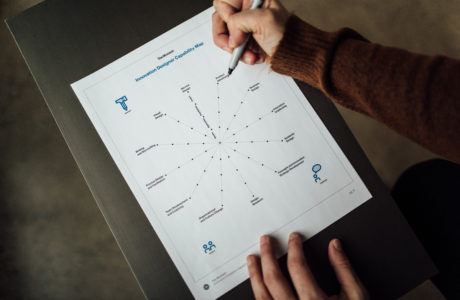How might we design kind and human-centred service experiences when our ‘customer’ has died?
I was on a client call recently chatting about synthesis. Always a juicy topic, but what struck me most was that the project they were working on was about benefits at the end of life. That grabbed my attention. Anyone that knows me well knows that I have a deep passion and belief that design can make a positive difference on the human experience at the end of life. It was my own journey through the loss of my father that led me down this path. I went back to school to do a Masters degree (OCAD University, Masters in Strategic Foresight and Innovation) as a way to work through my grief and did my major research project on the experience of distanced family members during palliative care. I have since collaborated with other designers and researchers on a series of public participatory installations engaging the public in conversations about death and dying.
Inevitably, when introducing myself to new clients, my work in death and dying always comes up. People are curious and almost always respond with the sentiment that the work is important. Until recently I generally viewed that work as part of my personal practice — my passion work. Something I know through personal experience and many conversations with others, is that there are many service experiences that touch death and dying that can be particularly hard on families (however you define family) after someone has died and often leading up to the death as well..
Consider all the services that support our day to day lives — banking, insurance, phone, cable and internet, subscriptions, etc — these all need to have an ending when someone dies. Most great service experiences are designed with an ending in mind. However that ending is often framed as a customer making a different choice. The transition or closure of banking, insurance claims or any other service when the ending is a death can be a very painful experience for those responsible for leading these administrative tasks. People are often in the midst of grief during these service interactions and many times the people we are engaging with are working within organizational systems and processes not really designed for death and they may not always be well-equipped to engage with the emotions that come with that experience.
I’ve often reflected on how customer delight is held up as an important aspect of designing excellent service experiences.
What should the goal be when delight is not possible?
There are many areas opportunities for creating services that support this phase of life within our systems and organizations:
- Ensuring government policies are supportive, accessible and easy to navigate for people and their caregivers and families (whomever we define as families)
- Providing equitable access, no matter the geography, to services within the health system such as palliative care, home care and hospice
- Creating accessible experiences for planning so that people can share their wishes before a crisis occurs is also important and has historically been challenging and uncomfortable for Canadians. This is a design challenge I’ve long grappled with. The good news is that this sentiment is shifting with a recent study by Advance Care Planning Canada revealing that 70% of Canadians now felt comfortable having advance care planning conversations.
Creating services that include a thoughtful, kind and human approach to ending a service that is part of daily living when someone dies is also critical and often overlooked or under-designed. Perhaps because businesses need to focus attention on the service experience of customers who are living; and, perhaps because it can be really hard to delve into this vulnerable phase of life.
So for 2023, I’m making it my mission to have as many conversations with people and organizations that can make an impact on the service interactions that touch end of life so that those often difficult, frustrating and draining experiences after a customer has died can be a little more positive and human at a moment we will all experience.
Whether you’re designing or shaping products and services that touch end of life, or simply grappling with these questions as well, I’d love to talk, hear about the challenges you face in doing this work, and share some of my own experiences in design for end of life.








